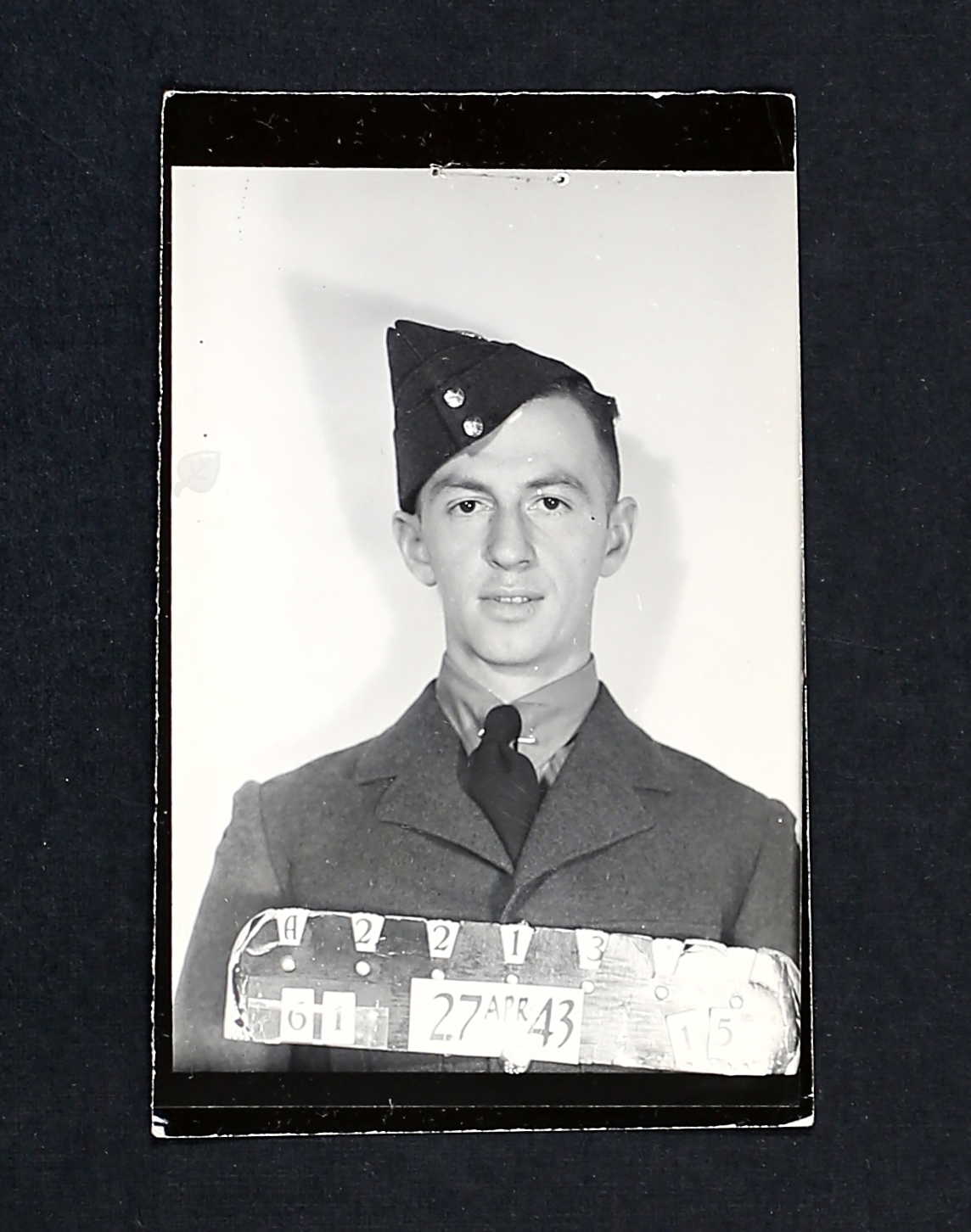
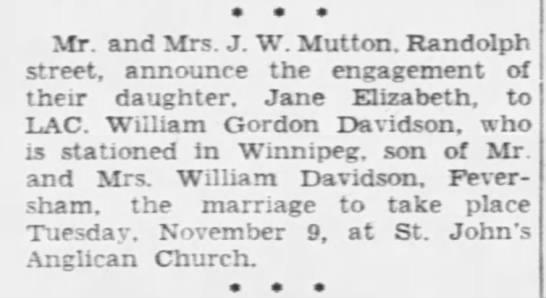
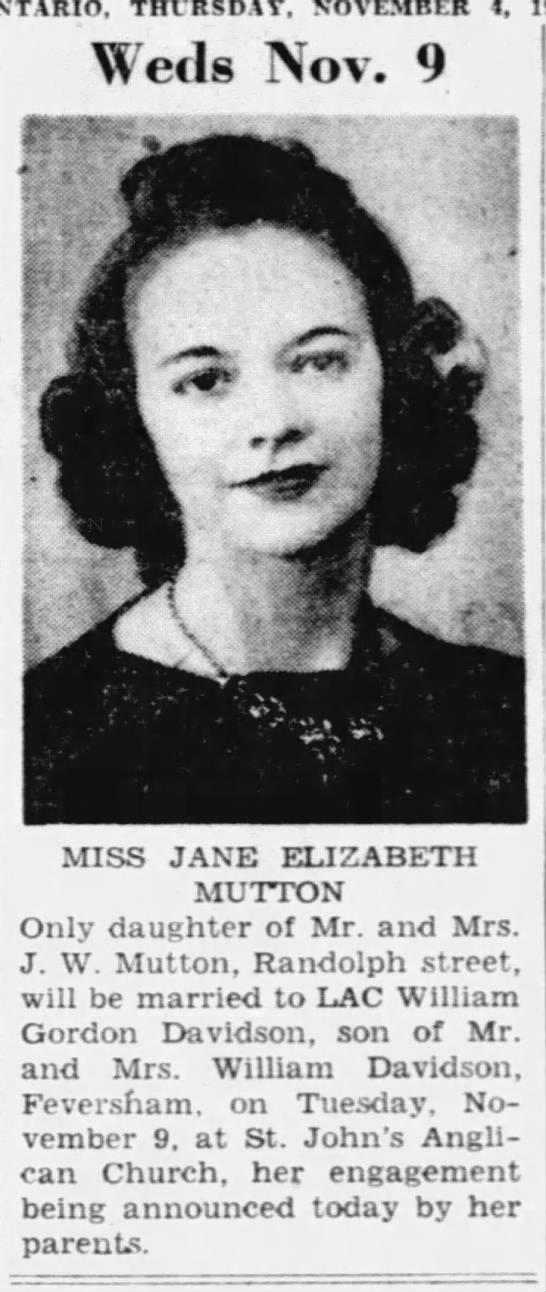


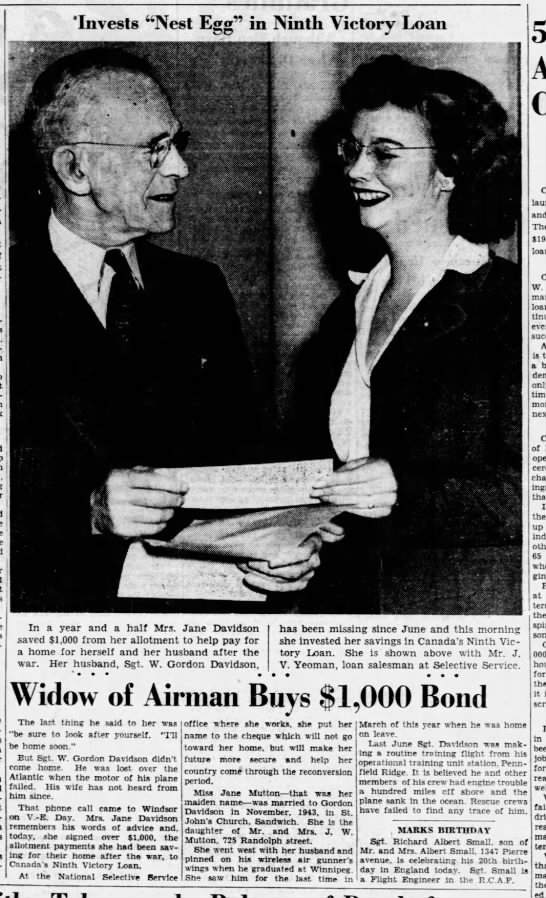
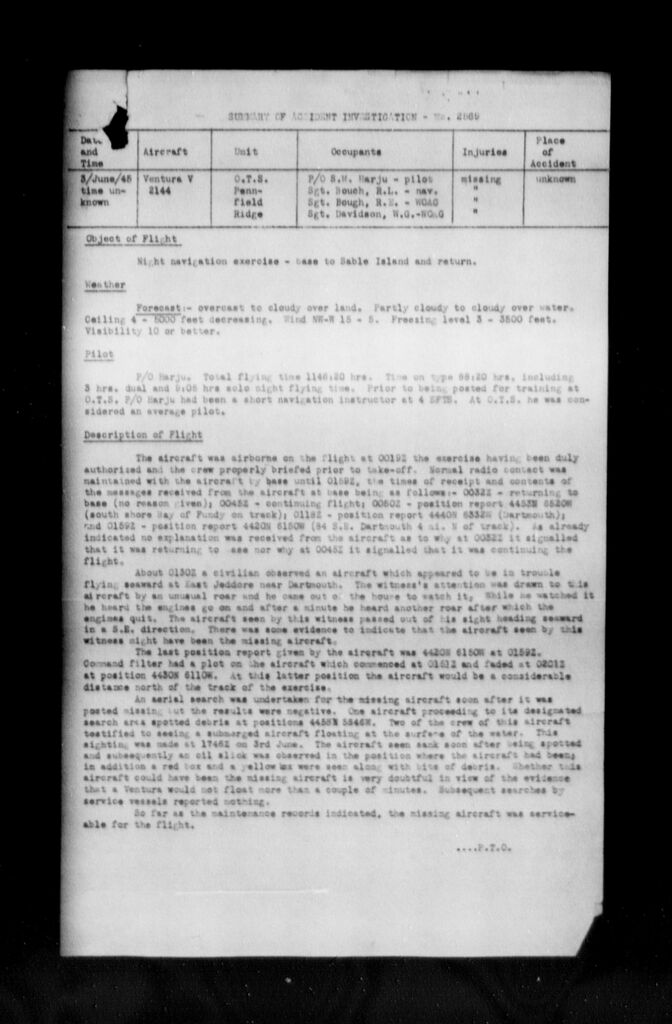
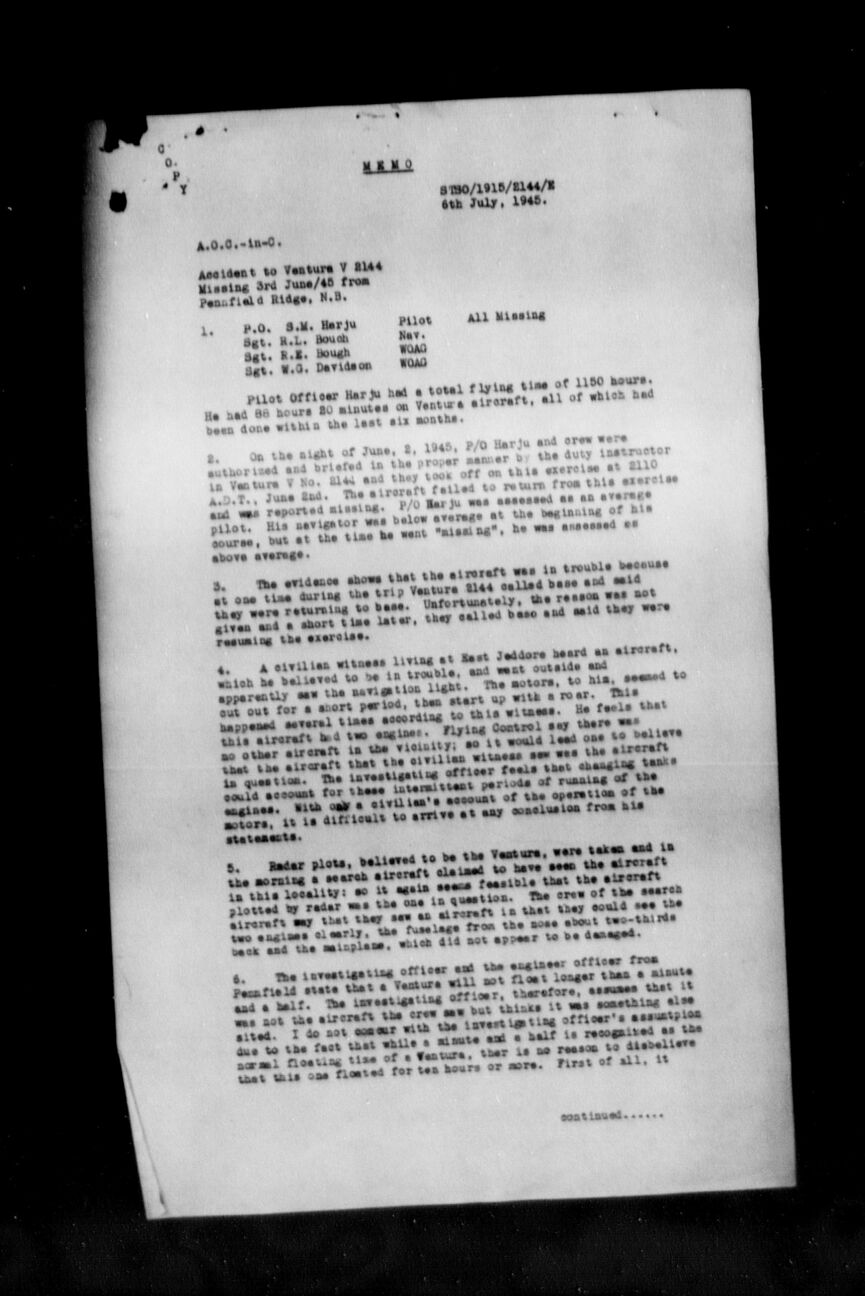
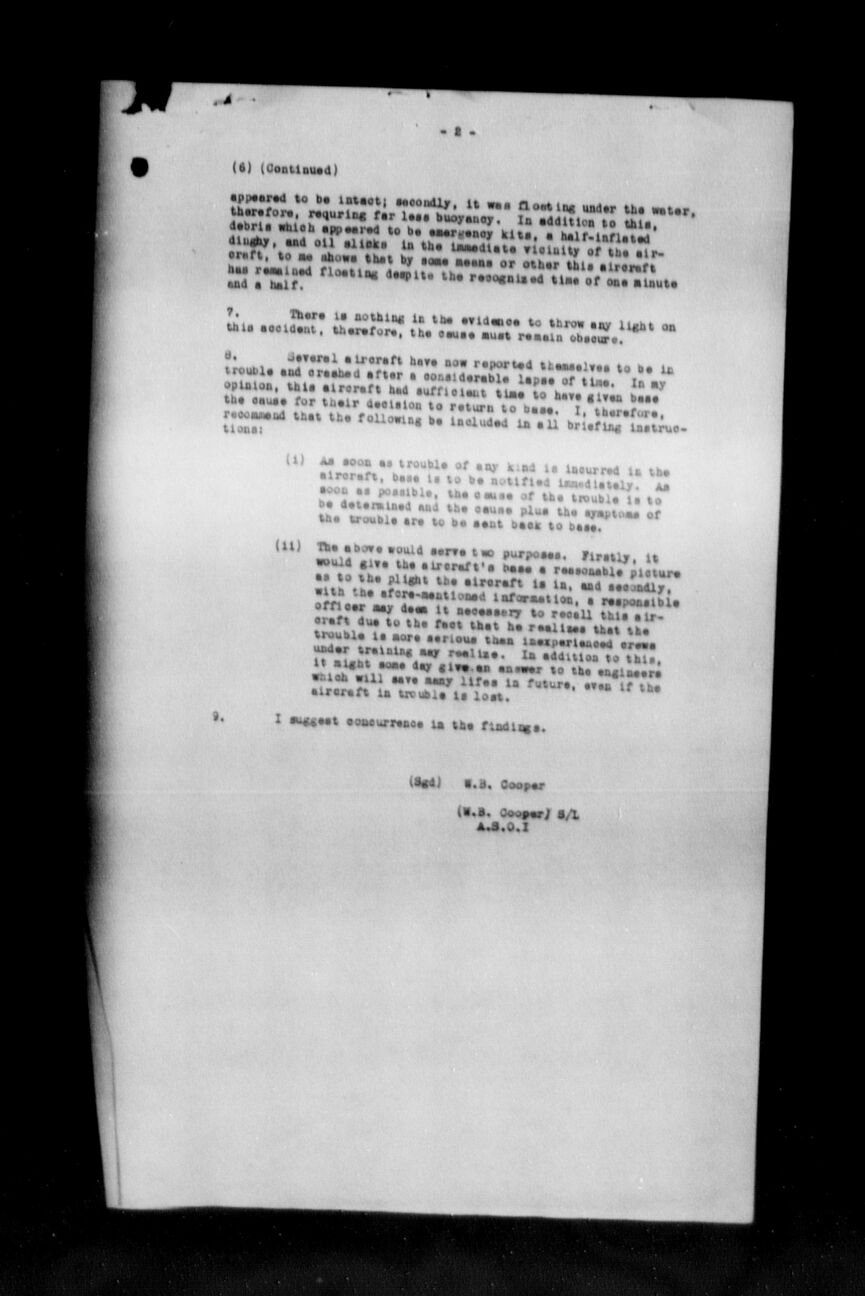
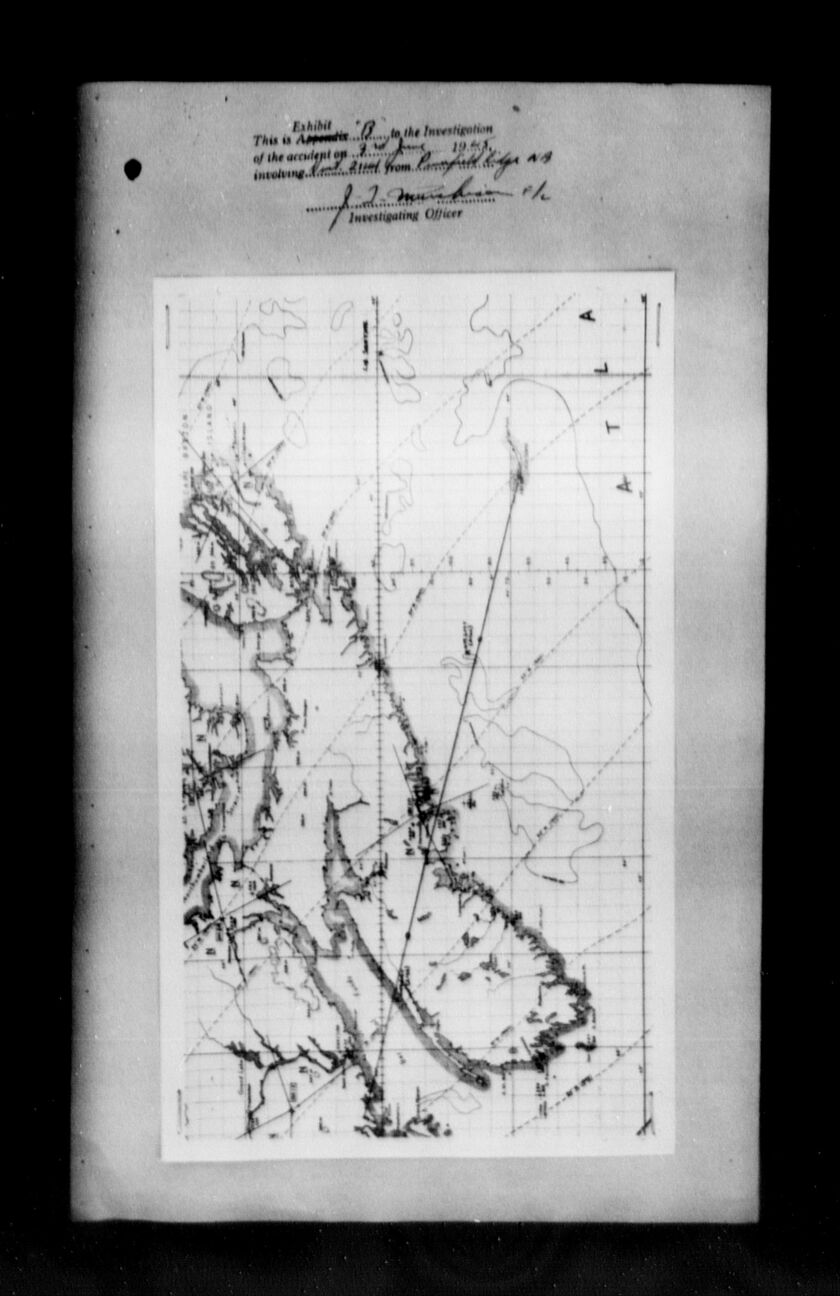
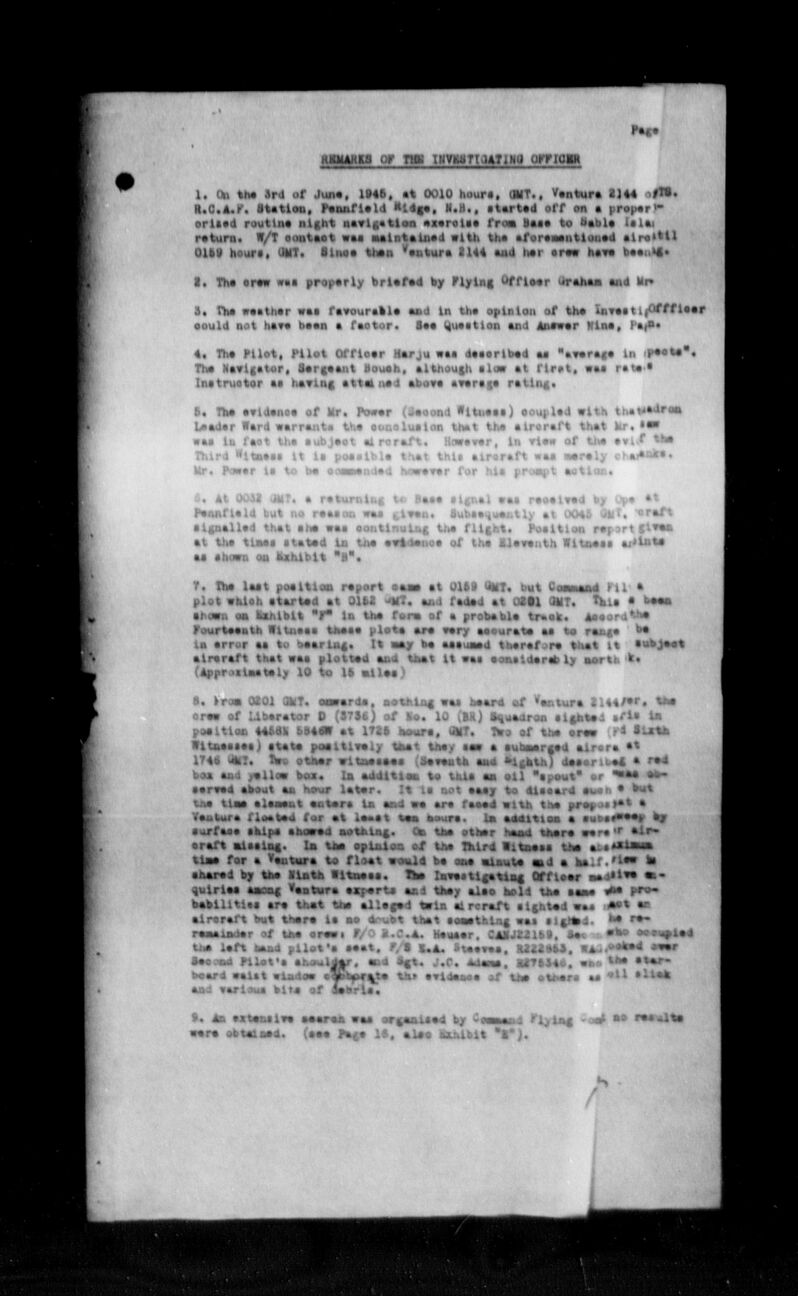
June 12, 1918 - June 3, 1945











William ‘Gordon’ Davidson, born in Feversham, Grey County, Ontario, was the son of William Munro Davidson (1878-1948), farmer, and Elizabeth Ann Maude (nee Buckingham) Davidson (1887-1923). His siblings were: Marjorie (1911-1928) who died of pneumonia, Gordon (1918-1945), Norman (1920-1944), Mervin, Donald, and Bert. His father remarried; stepmother was Margaret (nee Spoule) Davidson. Gordon, RCAF observer, was lost over the Atlantic and Norman was interred in Germany. The family attended the United Church. (His birth date is either June 10th or June 12th.)
Known as Gordon, he had scarlet fever at the age of ten and gonorrhoea at one point. He indicated he got seasick when it was exceptionally rough. He liked to play soccer and softball, enjoying hunting and fishing. He smoked a pipe occasionally and had beer moderately. He stood 5’9” tall and weighed 145 pounds, had brown eyes and brown hair. He was considered athletic with a standard mentality. “Small brown mark right chest posterior.”
Gordon did construction work as a carpenter, doing roofing and siding.
In the spring of 1943, Gordon had his medical. “Wiry build, quite talkative and seems nervous type. Has considerable self-confidence almost to the point of being braggard. ONLY fair MATERIAL.”
Gordon was married to Jane Elizabeth Mutton on November 9, 1943 in Windsor, Ontario. Jane indicated that William had a bank account with $152.10 at the Imperial Bank in Windsor. He also had $50 in Victory Loan Bonds, and a life insurance policy, amount payable $105 due to the war clause.
Gordon started his journey through the BCATP at No. 1 Manning Depot, Toronto, April 20, 1943. He was then sent to No. 1 SFTS Camp Borden June 5, 1943 before returning to Toronto and No. 1 ITS.
From there he was sent to No. 3 Wireless School, Winnipeg August 8, 1943 until February 25, 1944. Gordon then was in Paulson, Manitoba at No. 7 B&G School from February 26 to April 16, 1944. In April 1944, according to the Windsor Star, Jane travelled to Paulson, Manitoba for Gordon’s wings’ ceremony and pinned the emblem to his chest.
No. 1 AOS, Malton, Ontario was his next stop. Three Rivers and No. 3 AGTS by October to December 1944. He returned to Manitoba, this time heading to Portage la Prairie taken on strength at No. 7 AOS. January 13, 1945, he was at No. 1 WS, Mount Hope, Ontario until March 16, 1945, when he was sent to No. 1 O.T.U. Pennfield Ridge, NB.
Ventura 2144 was on night operational training flight was serviceable at time of take-off. There was a decision to turn back which was later reversed. The weather was good, and no distress signal was received at any time. The accident occurred approximately 100 miles east of Halifax.
Crew aboard Ventura GRV 2144: • Sgt Robert Leonard Bouch, R270058, navigator • Sgt Roy Edward Bough, R180547, WOAG • F/Sgt William Gordon Davidson, R221311, WOAG • F/O Sulo Matt Harju, J24723, pilot
A Court of Inquiry was struck. Fourteen witnesses were called. [Full file of accident in reel T12342, starting at image 4285.]
OBJECT OF FLIGHT: Night navigation exercises. Bae to Sable Island and back. WEATHER: Forecast: overcast to cloudy over land. Partly cloudy to cloudy over water. Ceiling: 4-5000 feet decreasing. Wing NWW 15-5. Freezing level 3, 3500 feet. Visibility 10 or better. PILOT: F/O Harju total flying time 1146.20 hours. Time on type 88.20 hours, including 3 hours dual and 9:05 hours solo night flying time. Prior to being posted for training at OTS, P/O Harju had been a short navigation instructor at No. 4 SFTS. At OTS, he was considered an average pilot. DESCRIPTION OF FLIGHT: The aircraft was airborne on the flight at 00192, the exercise have been duly just authorized and the crew properly briefed prior to take off. Normal radio contact was maintained with the aircraft by base until 00192, the times of receipt and contents of the messages received from the aircraft at base being as follows: 00322 returning to base bracket no reason given bracket; 00452: continuing flight. [They were then over Dartmouth, then SE of Dartmouth.]
In a memo dated July 6, 1945: “P/O Harju was assessed as an average pilot. His navigator was below average at the beginning of his course, but at the time he went ‘missing,’ he was assessed as above average. The evidence shows that the aircraft was in trouble because at one time during the trip, Ventura 2144 called base and said they were returning to bas. Unfortunately, the reason was not give and a short time later, they called base and said they were resuming the exercise.
“As already indicated, no explanation was received from the aircraft as to why at 00322 it signalled that it was returning to base nor why at 00452 at signal that it was continuing the flight. About 01302, a civilian observed an aircraft which appeared to be in trouble flying seaward at East Jeddore near Dartmouth. The witness’s attention was drawn to this aircraft by an unusual roar and he came out of the house to watch it. While he watched it, he heard the engines go on and after a minute he heard another roar after which engines quit. Seated the aircraft seen by this witness passed out of his sight heading seaward in a southeast direction. There was some evidence to indicate that the aircraft was seen by this witness might have been the missing aircraft. At this latter position the aircraft would be a considerable distance north of the track of the exercise. An aerial search was undertaken for the missing aircraft soon after it was posted missing but the results were negative. One aircraft proceeding to its designated search area spotted debris period two of the crew of this aircraft testified to seeing a submerged aircraft floating at the surface of the water. This sighting was made at 17462 on the 3rd of June. The aircraft seen sank soon after being spotted and subsequently an oil slick was observed in the position where the aircraft had been. In addition, a red box and a yellow box were seen along with bits of debris. Whether this aircraft could have been the missing aircraft is very doubtful in view of the evidence that a Ventura would not float more than a couple of minutes. Subsequent searches by service vessels reported nothing. So far as the maintenance records indicated, the missing aircraft was serviceable for the flight.
“Flying Control said that there were no other aircraft in the vicinity, so it would lead one to believe that the aircraft that the civilian witness saw was the aircraft in question. The investigating officer feels that changing tanks could account for these intermittent periods of running of the engines…The crew of the search aircraft way that they saw an aircraft in that they would see the two engines clearly, the fuselage from the nose about 2/3 back and the mainplane, which did not appear to be damaged. The investigating officer and the engineer officer from Pennfield state that if insurer will not float longer than a minute and a half. The investigating officer, therefore, assumes that it was not the aircraft the crew saw but thinks it was something else cited. I do not concur with the investigating officer’s assumption due to the fact that while a minute and a half is recognized as the normal floating time of a Ventura, there is no reason to disbelieve that this one floated for 10 hours or more. First of all, it appeared to be intact; secondly, it was floating under the water therefore, requiring far less buoyancy. In addition to this, debris which appeared to be emergency kits, 1/2 inflated dinghy, oil slicks in the immediate vicinity of the aircraft, to me show that by some means or other this aircraft has remained floating despite the recognized time of one minute and a half. There is nothing in this evidence to throw any light on this accident, therefore the cause must remain obscure… several aircraft have now reported themselves to be in trouble and crashed after considerable lapse of time period in my opinion, this aircraft had sufficient time to have given base the cause for their decision to return to base. As soon as trouble of any kind is incurred in the aircraft, base is to be notified immediately. As soon as possible, the cause of the trouble is to be determined and the cause plus the symptoms of the trouble are to be sent back to base. The above would serve two purposes. Firstly, it would give the aircraft base a reasonable picture as to the plight the aircraft is in, and secondly with the aforementioned information, a responsible officer may deem it necessary to recall this aircraft due to the fact that he realises that the trouble is more serious than inexperienced crews under training may realize. In addition to this, it might someday give an answer to the engineers which will save many lives in the future, even if the aircraft in trouble is lost.” S/L W. B. Cooper, ASOI
G/C F. S. Wilkins, CI Accidents concurred.
In June 1945, Jane wrote to the Secretary, Central Claims Committee, RCAF Benevolent Fund: “I wish to acknowledge with thanks your letter of June 19th expressing sympathy in the news of my husband, Sgt. W. G. Davidson, missing with the RCAF on the east coast. It gives me comfort to know that there is such a fund as the RCAF Benevolent Fund, and I am pleased to be able to tell your Directors that I am not in need of financial assistance. I am employed by the Dominion Government and hope to continue in its employ. However, I am pleased to feel if the need arises, that I have your Fund behind me. Again, let me thank you for your very kind thoughts and let me wish you every success in the purpose of your Fund.”
In the Windsor Star, October 20, 1945 edition, Jane is pictured buying a $1000 Victory Loan.
In January, Jane wrote a letter to the editor in the Windsor Star. (See above.). She mentioned her husband making the ultimate sacrifice.
In July 1946, Jane, from her home in Windsor, Ontario. wrote a letter to the Estates Branch of the RCAF in Ottawa. “It is indeed regrettable that [my deceased husband’s] effects were in such deplorable condition. I know without a doubt that most of the things did not belong to my husband but were substitues of other airmen who so callously rifled through his things. Why, when an airman is reported missing, cannot his things be closely guarded? It is a disgrace for his widow to receive, to put it plainly, ‘a lot of junk.’ Many articles, knapsack, shoes, electric razor had been stolen. In closing, might I say that I am disgusted with the manner in which my husband’s personal effect were handled. If it were possible, I would take this matter further, but realize it is hopeless.”
In late October 1955, Jane received a letter informing her that since William had no known grave, his name would appear on the Ottawa Memorial.
By August 1957, Jane was married to Lorne Rathwell of River Canard, Ontario.